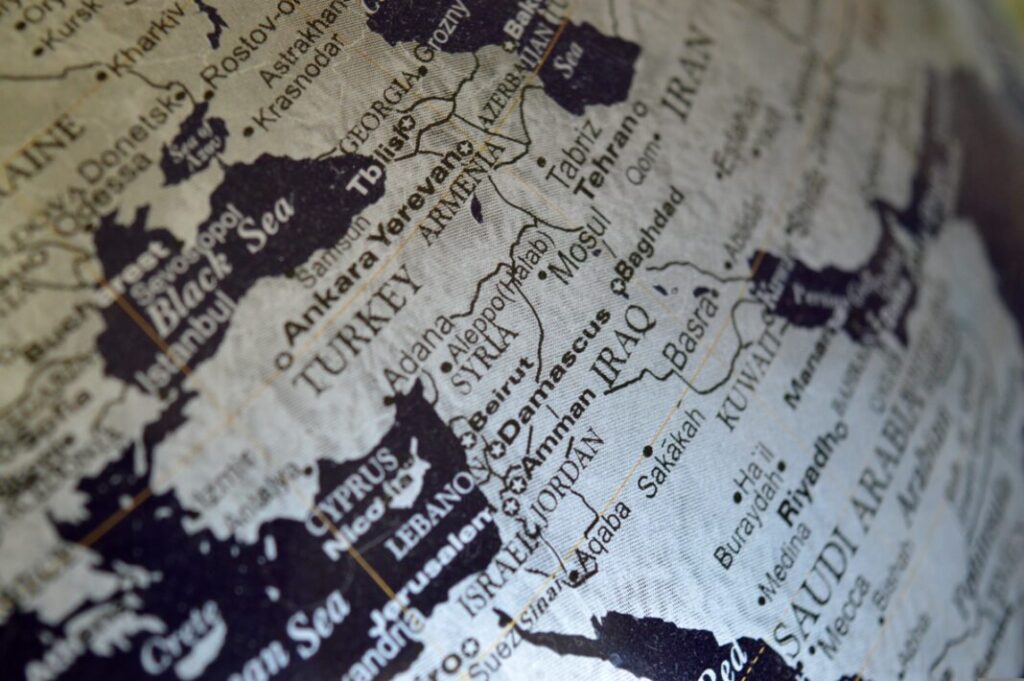No. 278 / planning article
Arabic “ta’aslum”
Recently, there is a new word that has emerged in the Arab world, “ta’aslum.” It refers to what is called “Islam” when it is not “Islam.” The active participle of “ta’aslum” is called “muta’aslim” and “muta’aslim” is a hypocrite who says he/she is a “Muslim” but does the opposite of what he/she says, and is a person who disobeys the commands of Islam. For example, “muta’aslim” means a Muslim who steals while praying five times a day. Therefore, the terms “ta’aslum” and “muta’aslim” can be applied to extremist Islamic forces such as the current members of “IS.”
The beginning of the “ISIS” crisis
A brief look at the “ISIS” crisis that until recently drove the world into fear, centering on the Middle East, it can be seen as a ruthless execution of “Kafir” by strong “Sunni” fundamentalist Muslims. In addition, for those without knowledge of sectarian conflict in the Middle East, the “ISIS” crisis may be perceived as a kind of terrorist incident that occupied the Iraqi region one day in June 2014, identifying themselves as the “Islamic State of Iraq and Syria (ISIS).”
However, those (ISIS), who were expected to be subdued soon, occupied major cities in northern Iraq, such as Tikrit and Baiji, shortly after occupying Mosul, the second largest city in Iraq at that time. And finally, while changing their name from the “Islamic State of Iraq and Syria (ISIS)” to the “Islamic State (IS),” declaring “Abu Bakr al-Bagdadi (died in 2019)” as their “Caliph” happened.
Only then did the world realize that the “ISIS” incident in the Middle East was not simply a temporary incident caused by an unknown terrorist group, but a very serious issue that could change the history and game of the Middle East.
Since then, the “ISIS” incident that started in the Middle East has expanded into the biggest event of this century in which many old problems in the Middle East are complicatedly intertwined. All countries in the Middle East and the West began to put their heads together to find a solution in a difficult situation where they did not know where to start and how to solve it.
“ISIS” from a Religious Perspective
The religious perspective of seeing the “ISIS” incident has several characteristics in connection with the concept of “Kafir” by Islamic “Sunni” conservative Muslims.
The first characteristics is the ultimate goal that they have. They declare the resurrection of the “Caliph” system, introduce their leader as “Caliph,” and aim to rebuild all Muslim communities and caliphate states transcending ethnicity and race.
Of course, it is impossible for the “Caliph” declaration to be recognized by the entire Islamic world. However, their hidden intention was their strong will to gain sympathy and recognition from at least Sunni Muslim around the world, while informing the world that they have the legitimacy of the descendants of the prophet Muhammad.
The second characteristics is the symbolic meaning of “black” that they put forward. At that time, they intentionally used black flags and black clothes, which is said to have been worn by the Islamic prophet Muhammad when he conquered Mecca (AD 630), wearing a similar black turban, and it seems to be intended to symbolize the legitimacy of this.
The third characteristics is a tendency of the international Islamic “Jihad” movement. Unlike other localized Islamic “Jihad” groups, they showed a propensity for an international movement, such as gathering mercenaries around the world. This can be seen as a strategy to consolidate their position in the world, whether it is negative or positive.
The fourth characteristics is a strong will to secure territory. Other terrorist groups known so far have mainly focused on providing psychological pressure through sporadic terrorist attacks as secret underground organizations. However, as “ISIS” occupied an area of a specific country extensively, it eventually showed a strong will to build a state that advocates Islam in that area.
The fifth characteristics is the use of psychological warfare strategies called “fear” and “horror.” Most of the Islamic militant groups are punishing their opponents in the name of “God” in the name of “Jihad,” and “ISIS” was no exception. However, the more special part is that public execution methods such as “decapitation” and the merciless and gruesome killing of numerous “Kafirs” with guns are partially disclosed through the media, causing extreme “feeling of fear.”
Two assumptions can be made about this. One is the idea of blocking the Western world from entering the Middle East through their brutal and fearful execution methods. Another is the idea of stimulating the West with their strategy of “fear” to join them in their war as a reason for retaliation and punishment.
If the former between the two conjectures is correct, ISIS will be able to expand their territory by consolidating a larger presence in the land. However, if the latter is correct, ISIS will be pushed out in the near future by coalition forces in the West and the Middle East.
Of course, even the latter could be one of the elaborate psychological warfare of ISIS. This is because, if the West enters the Middle East for suppression as the latter thinks, it can stimulate antipathy among Muslims around the world and cause an uprising under the pretext of entering the Western Christian world represented by “Kafir.” If that happens, the religious leadership of “IS” will automatically have that power, and thus it’s actually not such a bad strategy from their side. In other words, no matter what results are drawn from the extreme fear psychological warfare, they do not have a big problem in expanding their position in the land.
The last characteristics is a contradictory act of violating Islamic doctrine by itself. They showed a contradictory behavior regarding “decapitation,” which they claim is a legitimate method of punishment in Islam. For reference, the punishment of “beheading” has always existed regardless of the East and West, and the beheading has always been an extreme punishment reserved for high treason criminals.
The “decapitation” execution mentioned in the Qur’an chapter “Muhammad” verse 4 and chapter “Anfal” verse 12 is permitted only for those who reject “Allah” during war, that is “Kafir.” Therefore, it is a common opinion of most Islamic theologians that the concept of “beheading” should not be misused even within Islam. However, since most of the victims of the horrific “beheadings” by “IS” did not reject “God” during the war, as the Qur’an says¸ those who claim to follow Islamic law and tradition must be seen as committing errors and contradictions by not following Islamic law.
“ISIS” from a Political Perspective
The political perspective to understand the “ISIS” incident is as complicated as the religious one, and generally has the following characteristics.
First, the fall of “Sunni” Muslims in Iraq following the 2003 US attack can be linked to the recent “ISIS” crisis. At that time, the US attack on Iraq eliminated “Saddam Hussein,” who had claimed to be the leader of the “Sunni” Muslims in the Middle East. Since then, there has been a change of power in Iraq from a minority of “Sunni” Muslims to a majority of “Shite” Muslims. In Iraq, there was no longer a place for “Sunni” Muslims, who had been in power for 24 years from 1979. Therefore, fearing political retaliation, all the few “Sunni” Muslims who remained in the land were forced to leave the land, and it is they who later join the forces of “IS.” Therefore, if the “Saddam” regime had not been dismantled by the US, “IS” would not have appeared.
Second, it cannot be overlooked that “ISIS” was prepared like a fisherman at a time when Middle Eastern countries were busy with preparations for the Arab democratization protests that began in the Middle East from around 2010. The so-called “Arab Spring” or “Jasmine Revolution” that began in Tunisia in North Africa in 2010 blew a hot wind of democratization throughout the Middle East. However, when dictatorships are falling one by one in the Middle East due to this democratization movement, unusually, only in “Syria” in the “Levant” region of the Middle East, the citizens’ democratization movement has put a brake on it and has been progressing without any signs of ending until today.
Here, it is necessary to understand the situation in the Middle East at that time to examine the cause of the failure of the democratization movement in Syria, even though many countries in the Middle East faced a major change in identity as a result of the democratization movement at the time.
There are generally three reasons for this.
First, the success of the Arab democratization movement played a very important role in joining the government forces to the militia: however, in Syria, on the other hand, the ragtag Syrian militia was no match for the strong defenses of well-trained and loyal government forces.
The second reason is that the structure of the conflict between the “Sunni” and “Shi” sects of Islam was clearly revealed in the Syrian situation at that time. In other words, the Syrian citizen army, made up of “Sunni” Muslims, had to deal not only with Syrian Assad government forces, but also with neighboring “Shia” countries. In other words, the inability to break through the joint defense of the “Shia” states (Syria, Iran and later Iraq) formed in the “Levant” region should be seen as a key reason for the long-term war.
The last reason is the Russia’s active intervention in Syria at that time. Until then, Syria was Russia’s most important Middle Eastern stronghold, a country through which numerous Russian arms were sold. Therefore, Russia has been acting as an invisible and real force inside Syria. As a result, Russia could never stand by on the collapse of the Syrian government of Assad in a coordinated attack by Syrian militias of “Sunni” Muslims, other “Sunni” states and the West.
Therefore, the Syrian crisis at that time can also be seen as a clash between Russia, which embraced “Shia” Muslims, and the US, which stood on the side of “Sunni” Muslims to keep Russia in check. However, the problem is that the US, which unconditionally stood on the opposite side to contain Russia, which stood on the side of “Shia” Muslims in the region, is likely to be misunderstood as embracing “Sunni” Muslims and “ISIS.” As a result, it is easy to guess that the position of the US, which extremely hated the cruelty and fear policy of “ISIS” at that time, was in an awkward position.
Third, the characteristics of “ISIS” from a political point of view is that the “ISIS” crisis can be viewed from the point of view of the re-emergence of “Arab nationalism[6]” toward modern Western countries. Here, a brief historical look at the causes of Islamic terrorism in the Middle East: first, the cause can be found from the cause of the outbreak of WWI. Besides the typical reasons for the outbreak, which were well known at that time, there were two more cryptic and secretive ones. First, at that time, the Western powers were desperate to purchase “cheap raw materials” to revitalize their economies, and the other one is that the Western powers needed a market for products made by importing raw materials.
In the midst of this, crude oil came out of the Middle East, and the Western powers separated the Middle East, which had been the land of the Ottoman Empire, with the policy of “Divide and Rule” with qualifications as a victor in the World War in order to realize the above two secret conditions. At that time, France occupied Lebanon, Syria and Mosul in Iraq, and Britain occupied Iraq and Jordan. This is the “Sykes-Picot Agreement” secretly signed by “Mark Sykes” of England and “Georges Picot” of France in May 1916.
Here, France wanted to remain in Lebanon and Syria because of its historical religious and trade ties, and the British was struggling to maintain their oil fields in the Suez Canal and the Persian Gulf. At that time, Britain was determined to further strengthen its influence in the Middle East even after breaking its promise through the “Hussein-McMahon Letter” with Arab countries, so Arab independence at the time was naturally put on hold, and the Arabs had to endure the bitter pain of betrayal again.
In the end, Arab nationalists could not help but resent the fact that most of the Middle Eastern countries were now sitting on the desks of these Western powers and divided by a line with a ruler. ISIS was a group that used this historical fact politically to arouse new Arab nationalist feelings toward Western countries, represented by the US, and pursued a strategy to secure leadership in the Middle East.
In the end, a political war in pursuit of reality under the guise of an Islamic sectarian war
The “ISIS” incident seems to have exploded in the Middle East, a typical sectarian conflict that has been passed down through the past history in terms of religion, but at the same time, politically, the “ISIS” crisis looks like a war of resources with the same name, which started in the name of world peace against the background of Western countries, including the US and Russia, but in the end, or a battle between the great powers that repeats itself again and again.
At that time, the most important thing for “ISIS” to solidify its position was to be recognized as legitimized in the region. To this end, it was necessary to win public sentiment from local residents and continue to secure a funding line in the war. Of course, like both sides of the coin, on the contrary, it became an important strategy to drive “IS” out of the land.
In the end, the “ISIS” incident was a political war in pursuit of reality under the guise of an Islamic sectarian war. This is because we remember well the diplomatic warfare in pursuit of their own interests and practical interests that the international powers showed in the 19thcentury Western powers competition and the 20th century Middle East and Gulf wars. [Gospel Prayer News]
Kim, Jong-il
<Copyright©gnpnews> This article is allowed for those who pray for the world in God’s way. Please indicate source, gnpnews, and those who use this article let our head office know. Contact: gnpnews@gnpmedia.org





